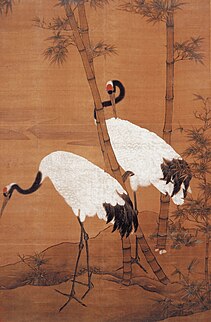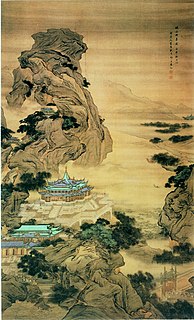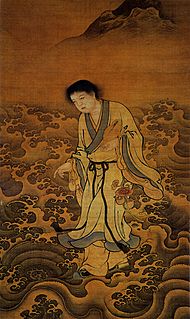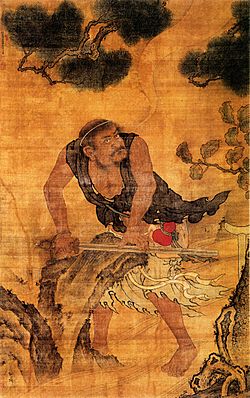
Yi Zhongtian is a Chinese writer and historian. He is also a professor and PhD supervisor at the Department of Chinese Language and Literature of Xiamen University's School of Humanities.

Bian Jingzhao, styled Wenjin (文进), was a famed Chinese painter in the early Ming Dynasty. His birth and death years are unknown. He was a native of Longxi in Gansu Province and was active 1426-1435.

Sun Long (simplified Chinese: 孙隆; traditional Chinese: 孫隆; pinyin: Sūn Lóng; Wade–Giles: Sun Lung; was a Chinese landscape painter active during the early Ming Dynasty. His specific dates of birth and death are not known, though he was active during the Xuande era.

Xia Chang originally named Zhu Chang, was a Ming dynasty Chinese painter and government official.
Yang Jin ; ca. (1644-1728) was a Chinese painter during the Qing Dynasty (1644–1912).

Yuan Jiang ; was a Chinese landscape painter who lived in the Qing dynasty (1644–1912). He served at the imperial palace during the Yongzheng era (1722–1735).

The Xianbei state or Xianbei confederation was a nomadic empire which existed in modern-day Mongolia, Inner Mongolia, northern Xinjiang, Northeast China, Gansu, Buryatia, Zabaykalsky Krai, Irkutsk Oblast, Tuva, Altai Republic and eastern Kazakhstan from 156-234. Like most ancient peoples known through Chinese historiography, the ethnic makeup of the Xianbei is unclear.

Zhang Shengwen ; was a painter from the Kingdom of Dali during the 12th century.

An Zhengwen ; was an imperial Chinese painter during the Ming Dynasty (1368–1644).
Wang Zhongyu was a Chinese painter during the Hongwu Era (1368–1398) of the Ming Dynasty. He was known for painting people. Little else is known of his life.

Xia Shuwen ; Date of birth unknown, was a Chinese painter during the early Ming Dynasty (1368–1644).

Guo Chun, was an imperial Chinese painter in the early Ming Dynasty.
Shi Rui, courtesy name also Shi Rui, was a Chinese landscape and building painter in the early Ming Dynasty. His birth and death years are unknown. He was a native of Qiantang and was active during the Xuande era (1426–1435) up to the Jingtai era (1449–1457). He served as an official at the Hall of Benevolence and Wisdom (仁智殿)

Ma Shi, courtesy name as Jingzhan (敬瞻), was a Chinese landscape painter and poet during the Xuande era of the early Ming Dynasty. His birth and death years are unknown. He was a native of Jiading.

Liu Jun, courtesy name Ting Wei (廷偉), was a Chinese landscape and person painter in the early Ming Dynasty. His birth and death years are unknown.
Chen Lu was a Chinese painter in the early Ming Dynasty. His birth and death years are unknown.

Ji Sheng, was a Chinese imperial painter during the Xuande era of the Ming Dynasty. His birth and death years are unknown.

Miao Fu, was a Chinese imperial painter during the Xuande era of the Ming Dynasty. His birth and death years are unknown.

Guan Tong was a Chinese painter of the Northern Landscape style during the Five Dynasties and Ten Kingdoms period and early Song dynasty from the city of Chang'an. He was a pupil of Jing Hao, and known as a critical figure in the development of the era's monumental landscape painting. His landscape paintings achieved a believable and compelling portrayal of the natural world, an achievement typifying the tenth-century artists drive in the portrayal of nature. The great popularity Guan's distinctive style achieved is one measure of the popularity of landscape painting at the time.
The Yu Gong or Tribute of Yu is a chapter of the Book of Xia (夏書/夏书) section of the Book of Documents, one of the Five Classics of ancient Chinese literature. The chapter describes the legendary Yu the Great and the provinces of his time. Most modern scholars believe it was written in the fifth century BCE or later.

















